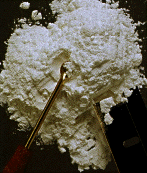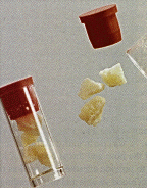A Guide to Drugs and the Brain
Commentary
Drug Effects
Drug Research
Drug Street Names
Back to NFIA
Cocaine
 Cocaine
and crack come from the leaves of the coca plant, which grows primarily
in South America. Cocaine is processed into a white powder which people
snort or melt and inject. Crack is further processed into a substance
that can be smoked
Cocaine
and crack come from the leaves of the coca plant, which grows primarily
in South America. Cocaine is processed into a white powder which people
snort or melt and inject. Crack is further processed into a substance
that can be smoked
Effects
Cocaine acts on the brain and is a highly
addictive drug. Because crack is smoked,
and allows high doses to reach the brain
rapidly, crack is even more addictive. Both forms of the drug trap a chemical
called dopamine in the spaces between the brain's nerve cells in a part
of the brain called the reward system. Dopamine stimulates and restimulates
these nerve cells, making the user feel intense pleasure. The brain responds
to the overabundance of
dopamine by destroying some of it, making less of it, and shutting down
the cells' receptors so they can no longer receive dopamine's messages.
The person consumes more cocaine more often in an effort to re-experience
the pleasure felt at first use, gradually losing control over his or her
cocaine-taking behavior and becoming addicted.
 Addicts
are preoccupied with getting their drug, and most of their thoughts and
behaviors are directed to that end.
Addicts
are preoccupied with getting their drug, and most of their thoughts and
behaviors are directed to that end.
Cocaine interferes with judgment and produces exaggerated feelings of
well-being and confidence. High doses can produce paranoia, and users
can become aggressive and violent. In rare cases, cocaine can produce
death, after first use or after prolonged use. Death occurs from cardiac
arrest (the person's heart stops beating), or seizures followed by respiratory
arrest (the person stops breathing). Pregnant mothers should never use
any drug during pregnancy. Scientists
are trying to understand the precise effect of cocaine on the developing
fetus. They know that a mother who is addicted to drugs
does not take care of herself properly, that her fetus does not
receive adequate nutrition needed to develop properly, and that
addicted mothers rarely care for their newborns properly.
Common Street
Names
Coke, blow, powder, sugar, nose
candy, rock, crack, base.
Legal Status
Cocaine is a Schedule II drug in the U.S. Controlled Substances Act. It
is illegal to grow, process, sell or use cocaine or crack. However, because
cocaine has limited use in medicine as an anesthetic, doctors may use
it in surgery.
About • Site Map • Privacy
© Copyright 2001 National Families in Action. All rights reserved.
Questions? Write to nfia@nationalfamilies.org.
